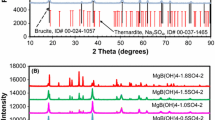Abstract
B-Nb2O5 was recrystallized from commercially available oxide, and XRD analyses indicated that it is stable in contact with solutions over the pH range 0 to 9, whereas solid polyniobates such as Na8Nb6O19⋅13H2O(s) appear to predominate at pH>9. Solubilities of the crystalline B-Nb2O5 were determined in five NaClO4 solutions (0.1≤I m /mol⋅kg−1≤1.0) over a wide pH range at (25.0±0.1) °C and at 0.1 MPa. A limited number of measurements were also made at I m =6.0 mol⋅kg−1, whereas at I m =1.0 mol⋅kg−1 the full range of pH was also covered at (10, 50 and 70) °C. The pH of these solutions was fixed using either HClO4 (pH≤4) or NaOH (pH≥10) and determined by mass balance, whereas the pH on the molality scale was measured in buffer mixtures of acetic acid + acetate (4≤pH≤6), Bis-Tris (pH≈7), Tris (pH≈8) and boric acid + borate (pH≈9). Treatment of the solubility results indicated the presence of four species, \(\mathrm{Nb(OH)}_{n}^{5-n}\) (where n=4–7), so that the molal solubility quotients were determined according to:
and were fitted empirically as a function of ionic strength and temperature, including the appropriate Debye-Hückel term. A Specific Interaction Theory (SIT) approach was also attempted. The former approach yielded the following values of log 10 K sn (infinite dilution) at 25 °C: −(7.4±0.2) for n=4; −(9.1±0.1) for n=5; −(14.1±0.3) for n=6; and −(23.9±0.6) for n=7. Given the experimental uncertainties (2σ), it is interesting to note that the effect of ionic strength only exceeded the combined uncertainties significantly in the case of log 10 K s6 to I m =1.0 mol⋅kg−1, such that these values may be of use by defining their magnitudes in other media. Values of Δ f G o, Δ f H o, S o and \(C_{p}^{\mathrm{o}}\) (298.15 K, 0.1 MPa) for each hydrolysis product were calculated and tabulated.
Access this article
We’re sorry, something doesn't seem to be working properly.
Please try refreshing the page. If that doesn't work, please contact support so we can address the problem.
Similar content being viewed by others
References
Cotton, F.A., Wilkinson, G.: Advanced Inorganic Chemistry, 2nd edn. Wiley-Interscience, New York (1988), p. 787
Hofmann, A.W.: Mantle geochemistry: the message from oceanic volcanism. Nature 385, 219–229 (1997)
Reimann, C., de Caritat, P.: Chemical Elements in the Environment—Factsheets for the Geochemist and Environmental Scientist. Springer, Berlin (1998), p. 398
Pudjanto, B.A.: The chemical state of fission products in uranium-oxide fuel. In: Prosiding Seminar Nasional Sainsdan Teknik Nukir P3TkN-BATAN, Bandung, Indonesia, 14–15 June 2005, pp. 236–244
Babko, A.K., Lukachina, V.V., Nabivanets, B.I.: Solubility and acid-base properties of tantalum and niobium hydroxides. Russ. J. Inorg. Chem. 8, 957–961 (1963)
Baes, C.F. Jr., Mesmer, R.E.: The Hydrolysis of Cations. Wiley-Interscience, New York (1976)
Etxebarria, N.E., Fernández, L.A., Madariaga, J.M.: On the hydrolysis of niobium(V) and tantalum(V) in 3 mol⋅dm−3 KCl at 25 °C. Part 1. Construction of a thermodynamic model for NbV. J. Chem. Soc., Dalton Trans. 3055–3059 (1994)
Mesmer, R.E., Holmes, H.F.: pH definition and measurement at high temperatures and pressures. J. Solution Chem. 21, 725–744 (1992)
Spinner, B.: Étude quantitative de l’hydrolyse des niobates de potassium. Rev. Chim. Min. 5, 839–868 (1968)
Goiffon, A., Granger, R., Bockel, C., Spinner, B.: Étude des équilibres dans les solutions alcalines du niobium V. Rev. Chim. Min. 10, 487–502 (1973)
Goiffon, A., Spinner, B.: Spectres Raman des solutions aqueuses du niobates de potassium. Rev. Chim. Min. 11, 262–268 (1974)
Jander, G., Ertel, D.: Über Niobsäuren und Wasserlösliche Alkaliniobate. I Lichtabsorptions- und Diffusionsmessungen an Alkaliniobatlösungen. J. Inorg. Nucl. Chem. 14, 71–76 (1960)
Neumann, G.: On the hydrolysis of niobates in 3 M K(Cl) medium. Acta Chem. Scand. 18, 278–280 (1964)
Jander, G., Ertel, D.: Über Niobsäuren und Wasserlösliche Alkaliniobate. II Präparitiv-analytische Untersuchungen. J. Inorg. Nucl. Chem. 14, 77–84 (1960)
Jander, G., Ertel, D.: Über Niobsäuren und Wasserlösliche Alkaliniobate. III Kinduktometrische Titrationen und vergleichende Röntgengraphische Untersuchungen. Das Hydrolyseschema der Isopolyniobate. J. Inorg. Nucl. Chem. 14, 85–90 (1960)
Wesolowski, D.J., Ziemniak, S.E., Anovitz, L.M., Machesky, M.L., Bénézeth, P., Palmer, D.A.: Solubility and surface adsorption characteristics of metal oxides. In: Palmer, D.A., Fernández-Prini, R., Harvey, A.H. (eds.) Aqueous Systems at Elevated Temperatures and Pressures: Physical Chemistry in Water, Steam and Hydrothermal Solutions, vol. 14, pp. 493–595. Elsevier/Academic Press, Amsterdam (2004)
Guillaumont, R., Franck, J.C., Muxart, R.: Contribution à l’étude de l’hydrolyse du niobium. Radiochem. Radioanal. Lett. 4, 73–79 (1970)
Lindqvist, I.: The structure of the hexaniobate ion in 7Na2O⋅6Nb2O5⋅32H2O. Ark. Kemi 5, 247–250 (1953)
Wagman, D.D., Evans, W.H., Parker, V.B., Schumm, R.H., Halow, I., Bailey, S.M., Churney, K.L., Nuttall, R.L.: The NBS tables of chemical thermodynamic properties. J. Phys. Chem. Ref. Data 11, 2–207 (1982)
Anderegg, G., Rao, L., Puigdomenech, I., Tochiyama, O.: In: Mompean, J., Illemassène, M. (eds.) Chemical Thermodynamics of Compounds and Complexes of U, Np, Pu, Am, Tc, Se, Ni and Zr with Selected Organic Ligands. Elsevier, Amsterdam (2005)
Robinson, R.A., Stokes, R.H.: Electrolyte Solutions, 2nd edn. Butterworths, London (1959)
Serafím, M.J.S., Bessler, K.E., Lemos, S.S., Sales, M.J.A., Ellena, J.: The preparation of new oxoniobium(V) complexes from hydrated niobium(V) oxide: the crystal and molecular structure of oxotris(2-pyridinolato-N-oxide)niobium(V). Trans. Met. Chem. 32, 112–116 (2007)
Gudasi, K., Maravalli, P., Goudar, T.: Thermokinetic and spectral studies of niobium(V) complexes with 3-substituted-4-amino-5-mercapto-1,2,4-triazole Schiff bases. J. Serb. Chem. Soc. 70, 643–650 (2005)
Vachirapatama, N., Macka, M., Paull, B., Műnker, C., Haddad, P.R.: Determination of niobium(V) and tantalum(V) as 4-(2-pyridylazo)resorcinol–citrate ternary complexes in geological materials by ion-interaction reversed-phase high-performance liquid chromatography. J. Chrom. A 850, 257–268 (1999)
Grenthe, I., Puigdomenech, I. (eds.): Modeling in Aquatic Chemistry. OECD, Paris (1997)
Mesmer, R.E., Baes, J.F. Jr.: Phosphoric acid dissociation equilibria in aqueous solutions to 300 °C. J. Solution Chem. 3, 307–322 (1974)
Author information
Authors and Affiliations
Corresponding author
Rights and permissions
About this article
Cite this article
Peiffert, C., Nguyen-Trung, C., Palmer, D.A. et al. Solubility of B-Nb2O5 and the Hydrolysis of Niobium(V) in Aqueous Solution as a Function of Temperature and Ionic Strength. J Solution Chem 39, 197–218 (2010). https://doi.org/10.1007/s10953-010-9495-z
Received:
Accepted:
Published:
Issue Date:
DOI: https://doi.org/10.1007/s10953-010-9495-z




